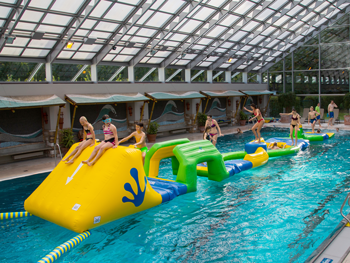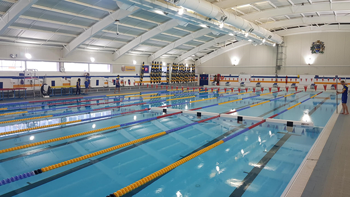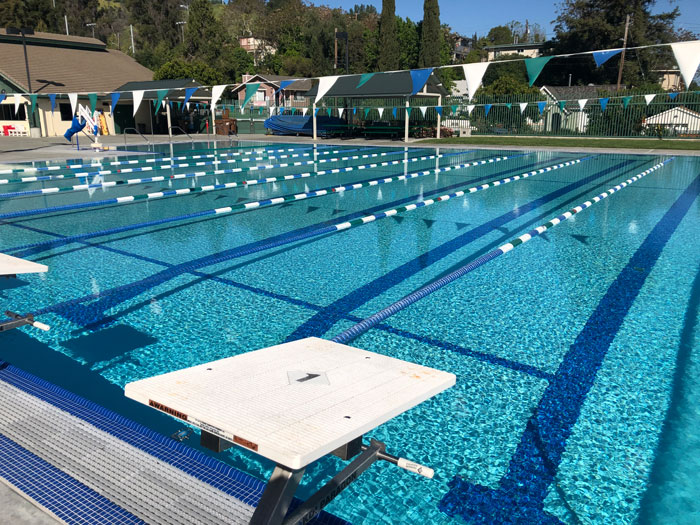Accessories to Improve Programming, Safety, Efficiency & Accessibility
Adding pool accessories is the easiest and most budget-friendly way to expand your aquatic facility’s programming and entertainment potential, improve safety and accessibility, and find new routes to operational efficiency. Many of those enhancements lead to extra revenue of course, which helps with return on investment.
If you’re building a pool, you’re not exactly adding accessories, but regardless of whether the project is new construction or a refresh/remodel, the choices for each goal are many.
Let’s break accessories down by category, then address accessories for competition-heavy pools.
Programming & Entertainment
Whether you plan to add classes like swimming and water aerobics, competitions and sports like water polo, or just plain fun, with obstacle courses and more, you can find equipment to help enhance such offerings.
To section off areas so that existing classes and events can continue alongside new ones, Kelle Snyder, commercial marketing manager for a manufacturer of commercial pool deck equipment, suggests mobile dividers like bulkheads.
A pool divider is capable of segmenting the pool into multiple bodies of water and allowing things like swim practice on one side and open recreational play on the other side, she said. “Without these pool dividers, you have to solely dedicate a facility to one or the other, and likely the recreational hours are the ones that get cut short,” said Snyder. “Now that you have dedicated space for recreational programming, this versatility allows a recreational facility to not only increase utilization but add revenue as well.”

George Deines of Counsilman-Hunsaker said some action-packed accessories that entered the scene in the past decade are holding their ground in popularity. “We are still seeing climbing walls and deck-anchored zip lines added to the deep end of the pool to add play value to that area of the pool,” he said. “Inflatables and the [retractable ninja course] are both amenities that can help turn a flatwater lap pool into a full-fledged obstacle course.”
Deines said the creativity of programming directors should be considered an accessory as well. “Special events have always been popular at indoor pools,” he said. “Programming an aquatic Easter egg hunt, a rubber duckie race in the current channel or lazy river, or even a dive-in movie night utilizing the timing system video board are great ways to offer community programs at your pool.”
For larger budgets, facilities can add whole new systems for more fun, said Justin Caron, principal and CEO of Aquatic Design Group. “The facility could design and build a new pool to complement their existing offerings, or renovate their existing pool to add more recreational elements, such as river current channels, vortexes, beach entry, interactive structures and interactive wet play elements,” said Caron. “The influx of new surfing technology can also be added to an existing facility, either in the pool itself, or nearby with one of several sheet flow and deep water surfing box waves.”
Safety
Caron said operators should make sure their pool surface and deck surface are predictable and have the right amount of slip resistance. Adding a fall-attenuation style surface around play features can help parents feel more comfortable bringing their children and reduce the potential liability on the operator, he said. Air and water quality are important safety features as well, Caron said. He suggested adding low-voltage/high-voltage fans, replacing or upgrading the existing pool dehumidification unit, installing UV, advanced oxidation process (AOP), or another secondary means of disinfecting pool water, and/or installing a source capture chloramine removal system.
Accessibility
Pools provide an environment that expands mobility for patrons with physical disabilities and other physical challenges, which makes it extremely important that ADA-approved access points are a part of the pool, said Snyder.
“Since pools and bodies of water come in all shapes and sizes, there are different requirements for each that make a pool ADA-compliant from zero-entry designs to aquatic access lifts,” she said. “In terms of lifts, there are numerous designs and features that can be best suited to any pool, ranging from portability to varying range of motions, but the most important topic in accessibility is the fact that the lifts must be usable and available at all times that the facility is open. This means diligent maintenance and monitoring of battery levels to ensure anyone who wants access to the pool will be able to get it on demand.”
Caron said lower-level sinks and counters for wheelchair-bound patrons are crucial, as is adding handrails and altering the deck surface with different finishes.
Operational Efficiency
Three of the four industry veterans interviewed for this story mentioned pool covers when asked for examples of accessories that increase efficiency. “Easily the most effective, yet labor-intensive, is actually using pool covers,” said Caron. “Close to 95% of your water loss, chemical use, and heat loss occurs at water surface level. Thus covering a pool, with properly balanced water, when not in use can greatly reduce resources and costs.”

Tina Wallen-Montalbano, who works for a provider of competitive and recreational aquatic equipment, agreed. “Pool covers and reels save customers significant energy and money by minimizing loss of water and chemicals through evaporation.” And to make it easier on your staff, “Automated pool reels can deploy and retract pool covers with the touch of a button,” she added.
“Facilities have options with thermal pool cover products that save and conserve not only on heating and water costs, but also chemical loss that comes with evaporation and water loss,” said Snyder. “Whether the facility is indoors or outside, warm climates or cool ones, there are measurable savings for those three items if you deploy covers on the pool during the off hours.”
Dienes chose differently. “Today’s standard for water conservation starts with regenerative media filtration on the pool side, and introducing gray water into toilets on the locker room side,” he said. “Variable frequency drives can be designed into the pool’s mechanical system as they increase the efficiency of the pump operation and extend the operational life of the pump to save on both operational and maintenance costs.”
Caron has a unique inclusion into the category of accessories: people. “In a world with lifeguard shortages, budget shortfalls, inflation, recession, supply chain issues, and mental health crises, never overlook the value your staff brings,” said Caron. “Reward staff members. Make them feel as special and important as they make your patrons feel.”
Competition
This category combines some of the other reasons and uses for accessories, and expands to include spectators. Dienes said the traditional components added to a pool to outfit it for competition are starting blocks, timing systems, spectator seating, deck space for athletes and support spaces to house timing equipment.
“We are seeing a more significant investment on videoboards, electronic displays and digital pace clocks, which are all key components that have become the expectation for any aquatic facility that is planning to host high-level competitive swimming events,” he said.
Just as there was consensus on pool covers for efficiency, there was agreement on the videoboard trend. “More and more facilities are adding video display scoreboards to enhance the competition experience,” said Wallen-Montalbano. These displays can show all of the timing data that they need, as well as live camera, instant replays, advertising and other graphics.”
James Trush, athletic director at Trenton (Mich.) High School, oversaw the construction of a new natatorium after the town passed a bond in 2018. When the facility opened in 2021, it boasted responsive timers on starting blocks, underwater speakers for coach-to-swimmer communication, seating for 400 spectators, and a videoboard connected to the timing system.

The board is used in a variety of ways other than to display meet information. It can play animation and video for entertainment and information and revenue-generating messages from parents and advertisers, said Trush. The football stadium also has a videoboard and there are LCD monitors at a few other Trenton High athletic venues. Thrush said these mediums are preferable to the traditional way of showing sponsor participation.
“We used to be the school before the bond was passed to say, ‘Just hang another banner, this person’s a sponsor,’” Thrush said. “We’re trying to get away from hanging banners all over the place. And now it looks very clean and you’re actually showing them when people are actually there.”
Snyder said starting blocks can be taken for granted by those outside the sport but they are central to competitive swimming. The block at Trush’s facility can detect not just if a swimmer starts early but if there are violations on exchanges in relay races, for instance.
“Seen by many as the crown jewel of any swim meet or facility, starting blocks are a pivotal set of equipment that can set a facility apart from the rest,” Snyder said. “There have been a lot of technological advancements in starting blocks in the past couple of decades including the addition of track-start style wedges, backstroke-start ledges, and advancements in the size and textures of the footboards themselves. Updating a facility’s starting blocks can not only make it easier for faster starts for the swimmers but make it safer for the full range of age groups competing.”
Caron said there are plenty of ways to remodel and retrofit a building to host high-quality competitions. “Existing facilities will always face constraints preventing them from achieving the kind of success that a new facility that is intentionally designed specifically for competitions can achieve,” he said. “For instance, an existing facility with limited deck space without raised seating and only one pool could never host a regional meet. However, there are lots of ways that an existing facility can improve its existing infrastructure or repurpose underutilized areas.”
Some of Caron’s suggestions include:
- Improving visibility: Many older facilities have either poorly placed lights that create glare on the water surface, lights that no longer work creating uneven light levels, windows that allow too much natural daylight, creating glare along the pool surface or shining in the eyes of the spectators, and even some facilities that have little to no natural daylight, said Caron. “Addressing light levels with well-situated LED lights that evenly distribute light throughout the space, introducing natural light, and shading or providing glazing to block glare from outside light sources can all greatly improve the ability of the facility to host competitions,” he said.
- Upgrading competitive equipment: Installing new starting blocks, replacing existing starting block tops with modern versions including a foot wedge, handholds and a backstroke foot wedge, resurfacing older diving board stands, replacing older boards, purchasing new water polo cages, and upgrading the scoreboard and timing system to a modern videoboard “will instantly make coaches and athletes want to utilize your facility,” said Caron.
- Provide better support spaces: If deck space is limited and you have access to an adjacent gym or alternative open space, you can provide a better environment for athletes in between events to stretch, relax and get away from the smells, noises and sounds of the competition. “Piping in announcements will help athletes and their coaches and parents feel confident the athletes won’t miss their next event,” said Caron. “Providing video of the competition or of the scoreboard showing event and heat number or match also can help make the disconnected space feel intentional and connected.”
Finally, said Caron, small details can make a big difference. “Simple things like resurfacing the pool or the pool deck, adding some art, pictures, graphics and record boards can all make the facility feel more like a competitive venue and less like a practice venue,” he said.
That sort of mindset applies to recreational settings as well. Similar to the challenges that an existing competitive facility faces, an existing multipurpose or rec pool faces some inherent challenges in trying to compete with a new facility.
“The good news is in many cases it is easier to upgrade recreational programming without having to spend a ton of money,” Caron said. “A boring rectilinear pool can add things like inflatables, zip lines, climbing walls or rope swings to create new programmatic offerings and create fun and excitement. If budget allows, adding a waterslide or obstacle course to an existing pool can create a destination program.”
Other competitive accessory details include:
- Different from recreational lanes, which only need to indicate location of areas and lanes, anti-wave racing lanes feature a flow-through system to provide consistent wave quelling from one lane to another. They should also be made of materials that resist water chemicals for longer life.
- Backstroke flags hang above the pool to guide swimmers during the race.
- Dive flash cards for judges.
- Deck stanchions to string various markers over the pool.
- Bulkheads to maximize lane usage.
Miscellaneous Items
Some patrons will spend even more time on the deck than in the pool itself. Amenities can be added here to make your facility more comfortable for these visitors. Consider adding chairs and tables, including comfortable lounge chairs, as well as umbrellas to protect visitors from unwanted sun exposure. Trash and recycling receptacles are also important, and should be covered to prevent waste items from getting into your pool.
Drowning continues to be a leading cause of death for children ages 1 to 14, and studies have shown that formal swimming lessons can reduce the risk of drowning by 88%. Demand for swim classes is as high as ever, especially after the limitations imposed by the pandemic. Instructors and students need specialized tools to maximize their time in the pool.
While kids wait their turn, they need a place to safely and comfortably pay attention. A hanging swim bench provides schools with an in-water platform for students and instructors. They should be sturdy and provide a nonslip surface suspended above the pool bottom. There are also versions of platforms for mid-pool locations. These sit on the pool bottom.
Water aerobic classes have been popular for decades but fitness-minded folks can also work out using equipment more commonly seen on dry land, like stationary bikes and treadmills. These are also great tools for folks rehabbing injuries. Bikes offer multiple seat options and are made from materials that resist water and chemicals, like powder-coated stainless steel.
Cleaning tools, safety items and signage are essential but not glamorous. Leaf and bug skimmers; deck and wall scrub brushes; deck squeegees; vacuums; lifeguard chairs; first-aid kits; life vests and rings; bloodborne pathogen cleanup kits; defibrillators; eyewash stations; depth markers; and “No Running” signs—all are important for staff and swimmer care. RM



